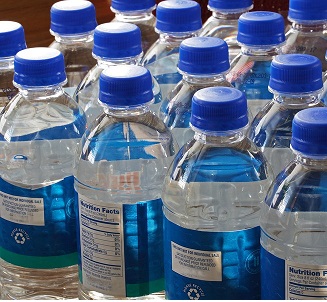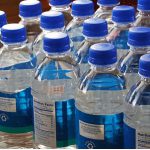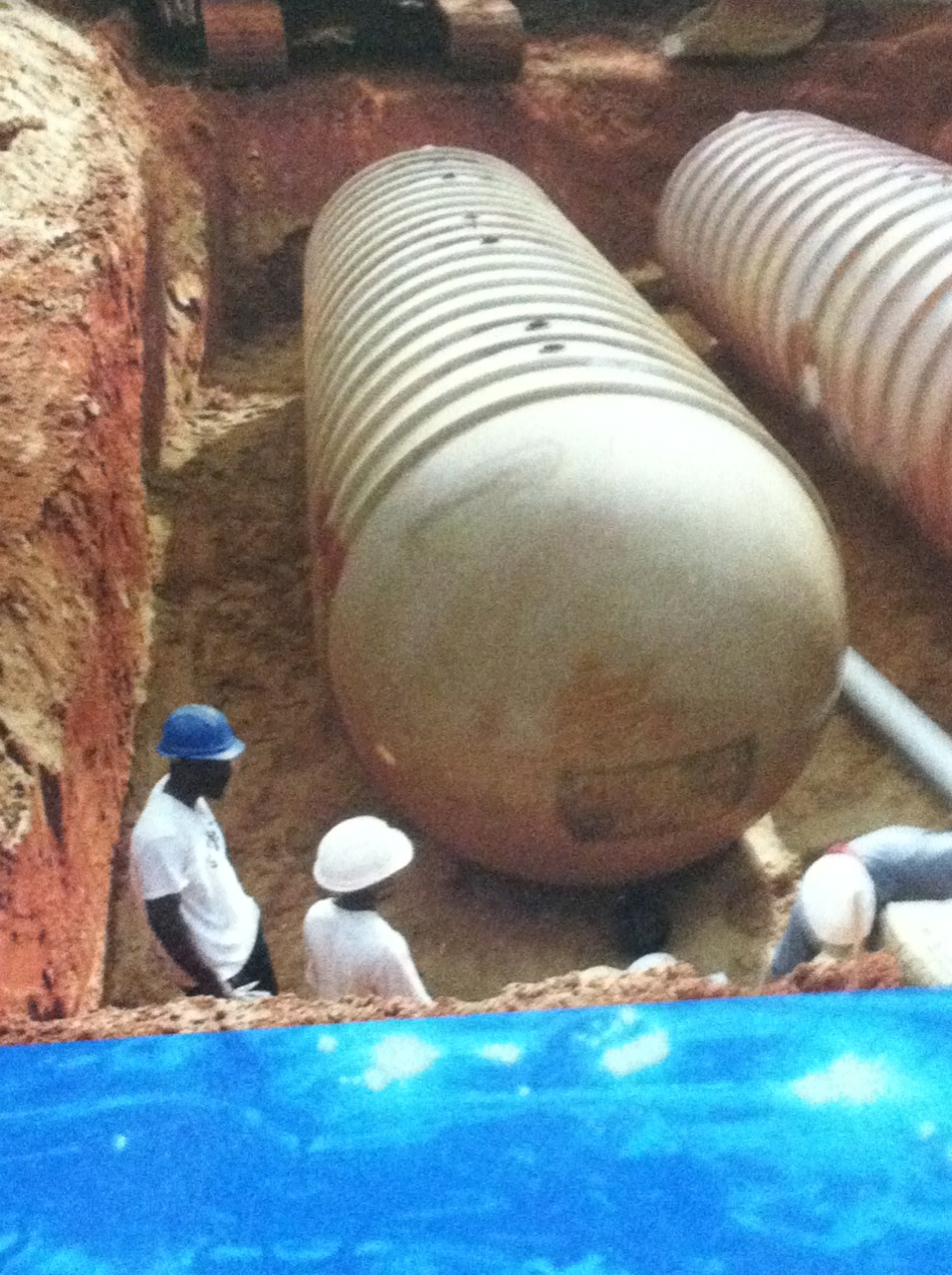
by Dorothy C. Lee | Jun 27, 2017

Carry water with you to sip throughout the day
Summer has arrived! During the summer months, especially along the Gulf Coast, it is hot and humid. Keeping the body hydrated is important to maintaining good health.
As the temperature rises in the summer and the body loses more water through evaporation and perspiration, it makes good sense to increase your intake of fluids. Keep in mind that by the time you notice you are thirsty, you have already depleted your water stores dramatically. A good rule of thumb is to drink a few ounces of water every fifteen to thirty minutes when you are working or playing hard in the heat.
- Myth or Fact – You should drink at least eight glasses of water a day.
Myth – On average, the body requires a half gallon of water daily. That’s the amount required to replace what has been lost through perspiration, evaporation, and body waste. Milk, juice, and other fluids can be added to your daily total. Beverages that contain caffeine, such as coffee, tea, and soft drinks, are not good substitutes for water. Caffeine actually may cause the body to lose water. The same is true for alcoholic beverages. They contribute to water loss, not gain, because alcohol acts as a diuretic.
- Myth or Fact – All water is the same.
Myth – The following guide will help you navigate the sea of choices available:
- Distilled Water – is pure water with no added chemicals or minerals.
- Mineral Water – is available in canned or bottled varieties. Many brands include a mix of minerals to improve the taste. Natural or artificial flavors, such as lime or lemon, may be added to some. Some varieties add sugar. Check the label.
- Soft Water– commercially softened water often is treated with salt and tends to be high in sodium.
- Sparkling Water– some sparkling waters contain bubbles naturally; others are created with the addition of carbon dioxide.
- Well Water – is more commonly known as tap water.
- Myth or Fact – Increasing daily water and fluid intake is difficult.
Myth – Actually, there are a variety of ways to increase water and other fluid intake. Purchase a insulated water bottle and refill it throughout the day. Add flavor to water. Infused water is becoming a popular food trend. Infuse with strawberries, lemons, limes, or other flavorful fruits and vegetables. Choose foods that contain high levels of water content – for example, watermelon, grapes, and kiwi. Start the day with a glass of water at breakfast.
- Myth or Fact – Water aids in bodily functions.
Fact – Water contributes about sixty percent of an adult’s body weight. Staying hydrated may be a major benefit to increasing energy production. Increased water consumption can aid in weight loss. Water aids in the body’s temperature regulation, acts as a lubricant, and cushions around joints. Water serves as a solvent for minerals, vitamins, amino acids, and glucose. Because water is vital to bodily functions, the body directs many of its activities toward maintaining balance.
- Myth or Fact – You can drink too much water.
Fact – Over-hydration can result in water intoxication. Water intoxication occurs when you consume more water than the kidneys can excrete. Consuming large amounts of water in a short period of time can result in intoxication. Remember, you should drink at least eight glasses of water a day – it’s a fact.
Reference: https://authoritynutrition.com/7-health-benefits-of-water/

by Heidi Copeland | Apr 25, 2014

Leon County Extension’s sustainable rainwater cisterns collect rainwater from the rooftop and use the water from the cisterns to irrigate the demonstration garden.
According to the Environmental Protection Agency (EPA), the term “sustainability” has emerged as a result of significant concerns about the unintended social, environmental, and economic consequences of rapid growth. Sustainability is based on a simple principle: Everything we need for our survival and well-being depends, either directly or indirectly, on our natural environment. Therefore, sustainability creates and maintains the conditions under which humans and nature can exist in harmony, fulfilling the social, economic, and other requirements of present and future generations.
WHEW! Think about it! Sustainability is important to making sure that we have, and will continue to have, the water, materials, and resources to protect our health and our environment.
Think about it! Water, for instance. Though we might see water as an abundant resource in Florida, water is emerging as a sustainability issue sparking debate and illustrating the differences in opinions of various water users in Florida. Consider these facts:
- Heavy demand: High levels of commercial, real estate, and agricultural development have caused withdrawals to increase over time, putting pressure on natural resources.
- Changes in water use: Agricultural production and public supply are the largest users of freshwater resources in Florida. Large demands occur in municipal water supply systems as a result of landscape irrigation of lawns and golf courses.
- Environmental consequences: Depletion of groundwater resources can have negative environmental consequences, such as saltwater intrusion into freshwater resources and sinkhole development.
- Water use strategies: Strategies to balance water use include reducing the overall demand for water (through such means as increased water prices or restrictions) or increasing the supply of water (through such means as desalination of seawater).
- Water quality: Recent EPA nutrient requirements designed to protect water quality.
Just think about it! Just like there are many levels of sustainability, each and every one of us can draw from advances in science and technology to protect not only our health but the environment.
Just think about it! And then take action. The EPA website has data specific to your area of interest. Information on air, water, land, community, health, and energy can be visualized on a map, downloaded, and printed.
Think about it! Individuals can make a difference! A journey of a thousand miles begins with a single step. Each of us can promote practices to strengthen our natural environment and quality of life, ultimately improving the quality of life for everyone.
Sources: http://www.epa.gov/
UF/IFAS FCS 7242 Understanding Sustainability: The Importance of Sustainable Development and Comprehensive Plans—Goals, Objectives, Policies
UF/IFAS WC151 Water Issues in Florida: How Extension Can Facilitate Stakeholder Engagement and Involvement
by Shelley Swenson | May 20, 2013

Salt water continues to make it into our fresh water supply. Will you conserve?
I had the privilege of spending a day recently with children from Medart Elementary School for their annual Project Learning Tree (PLT). During PLT, community representatives make presentations on nature, conservation and sustainability practices. The 2013 theme was Wakulla Life is Nice!
I decided to speak on water conservation since we live in such a wonderful part of Florida with an abundant amount of clean, fresh water. Through an imaginary trip to Wakulla Springs, the children and I noted the clear water and discussed how and why it remains that way. We concluded that we were quite special to have the Springs so close by to enjoy. I reminded them that people visit Wakulla Springs from all over the world to witness the clear, clean water and that water is not that way for many people around the world. I used a poem written by a student who wrote,
“When I look through my water window….
I see lake water for fun.
I see ocean water for surfing.
We’ve got water by the ton!
But when I look a little closer for the part that we can use,
I see we’ve only got a little;
if I waste it – we ALL lose!”
The students were reminded that even if a world map looks like it contains a lot of water or 71% of its surface, 96% is salt water and the other 4% is fresh. When looking at it through this lens, the amount of water on the earth’s surface looks somewhat different. We decided that there was “water, water everywhere, but only a few drops to drink.”
I suggested ways that they might assist to save the 4% of fresh water on the earth’s surface. The United State Environmental Protection Agency offered some great facts to allow the children to get a better grip on how people use or misuse water. For example, did you know that:
- A household can save up to 20,000 gallons of water each year by fixing leaky faucets. A leaky faucet puts 3-5 gallons of water down the drain every minute.
- More than five gallons of water is wasted if the tap water is running while brushing teeth. Only ½ gallon of water is used if the toothbrush is just wetted and rinsed. This results in a 4 ½ gallons savings each time teeth are brushed.
- Washing dishes with the tap running can use an average of 30 gallons of water.
- Washing a car at home, using a hose, uses up to 150 gallons of water. Washing a car at a self-service car wash uses 5-10 gallons. Using a sponge and a bucket, uses 1.5 gallons.
- Taking a bath uses between 30-50 gallons of water. A 4 minute shower takes 20 gallons. If your shower is longer, it could use more water than a bath so the secret is with either a bath or shower, to get in, wash and turn the water off. A low-flow showerhead will also assist in the saving of water.
I then asked the children to sign a pledge. It read: “PLEDGE TO SAVE WATER. I know that our Earth’s water supply is limited. I will do my part. I will turn off the water while brushing my teeth and I will shorten my shower to 4 minutes.” 99% of the Medart Elementary students who participated signed the pledge. I was proud of them and the decision that they made.
Are you willing to conserve water to keep the world from losing the fresh water available??





